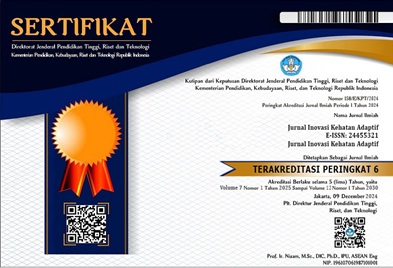HUBUNGAN FREKUENSI, JENIS PEMBERIAN DAN TEKSTUR MP-ASI TERHADAP KEJADIAN UNDERWEIGHT PADA BADUTA USIA 6-24 BULAN DI WILAYAH KERJA PUSKESMAS BOGANATAR TAHUN 2024
Kata Kunci:
Frekuensi Pemberian MP-ASI, Jenis Pemberian MP-ASI, Tekstur MP-ASIAbstrak
Frekuensi, jenis pemberian dan tekstur MP-ASI sesuai standar mempengaruhi pertumbuhan dan perkembangan baduta pada masa golden age. Tujuan penelitian ini untuk mengetahui hubungan frekuensi, jenis pemberian dan tekstur MP-ASI terhadap kejadian underweight. Metode penelitian kuantitatif dengan menggunakan desain cross-sectional. sampel penelitian terdiri dari Baduta yang mengalami masalah gizi underweight usia 6-24 bulan. Hasil menunjukkan adanya hubungan signifikan antara frekuensi pemberian MP-ASI dengan kejadian underweight (p<0,05) dan jenis pemberian MP-ASI terhadap kejadian underweight (P<0,05). Namun, tidak ditemukan hubungan yang signifikan antara tingkat tekstur pemberian MP-ASI terhadap kejadian underweight(p>0,05). Kesimpulan frekuensi dan jenis pemberian MP-ASI berhubungan dengan kejadian underweight, sedangkan tekstur MP-ASI tidak berhubungan secara signifikan dengan kejadian underweight.
The frequency, type, and texture of complementary feeding (MP-ASI) according to standards influence the growth and development of children under two during the golden age. Objective: This study aims to determine the relationship between the frequency, type, and texture of complementary feeding and the incidence of underweight in children under two years old. Methods: This is a quantitative study using a cross-sectional design. The research sample consisted of children aged 6–24 months who were identified as underweight. Results: The study found a significant relationship between the frequency of complementary feeding and the incidence of underweight (p<0.05), as well as between the type of complementary feeding and underweight (p<0.05). However, there was no significant relationship between the texture of complementary feeding and the incidence of underweight (p>0.05). Conclusion: The frequency and type of complementary feeding are associated with underweight status, whereas the texture of complementary feeding is not significantly related.





